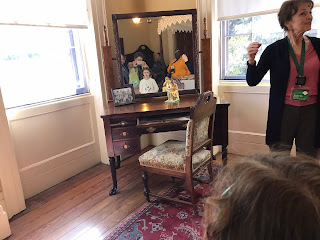Good Stories at an Old House
In February, three generations Slavin/Langer/DeAngelis women traveled to Savannah for a weekend of cultural immersion, fun, and togetherness. We had a fabulous time. Our experiences are well-documented, and we'll have lots of good stories to tell.
It seems that Savannah wouldn't want it any other way. Lacking the corporate/financial downtown present in most contemporary cities, Savannah seems to rely on two major industries: shipping and tourism, with a small dose of the education/medical sector thrown in for support. Thus, storytelling is at the heart of the city's agenda for its visitors.
Founded in Savannah in 1839, the Georgia Historical Society is one of the oldest in the country. Savannah's focus on historic preservation has meant that it is home to some of the best-preserved architectural stock in the country. But what stories do these buildings tell?
Among others, they tell stories of the architect Hyman Wallace Witcover. As a member of the digital exhibits advisory board for the Georgia Public Library Service, I had a courtside seat to the development of Live Oak Public Libraries' new digital exhibit all about the architectural contributions of this American son of German Jewish immigrants who called Savannah home from 1888 to 1932. Witcover's buildings include many civic and religious structures, ranging from banks to cathedrals.
Yet for many, Savannah's private homes contain the most sought-after stories. In that vain, our family enjoyed a tour of the childhood home of Juliette Gordon Low, the founder of the Girl Scouts. Like other contemporary house museums, the Gordon Low birthplace has recently endeavored to tell a more complete story, including the voices of people who had been enslaved in the home, and others beyond the "great family" who gave the place its well-known name. The last time I was in Savannah, I was impressed by the new interpretation at the Owens-Thomas House & Slave Quarters. When I entered the Gordon Lowe house, owned and operated by the Girl Scouts since 1953, I'll admit that I expected a hagiography of Juliette Gordon Low. Instead, we were treated to a thoughtful docent tour which put Low's life in context, from her young childhood in the care of an enslaved nanny who celebrated the arrival of Sherman's troops in the city to her struggles with disability and disappointment. The Girl Scouts organization acknowledged its founding among the elite young women of Savannah and its commitment to expansion and inclusion, with the Girl Scouts among the earliest proponents of desegregation in the 1950s. We all left feeling inspired and engaged in the best tradition of immersive museum storytelling. Kudos!
 |
| Reflections and Ceramic Sculpture inside the Juliette Gordon Low Birthplace |
 |
| A modern library inside the Juliette Gordon Low Birthplace |
 |
| A certain six-year-old tourist outside the Juliette Gordon Low Birthplace |
 |
| That same six-year-old visitor outside the Olde Pink House restaurant in Savannah |
Comments